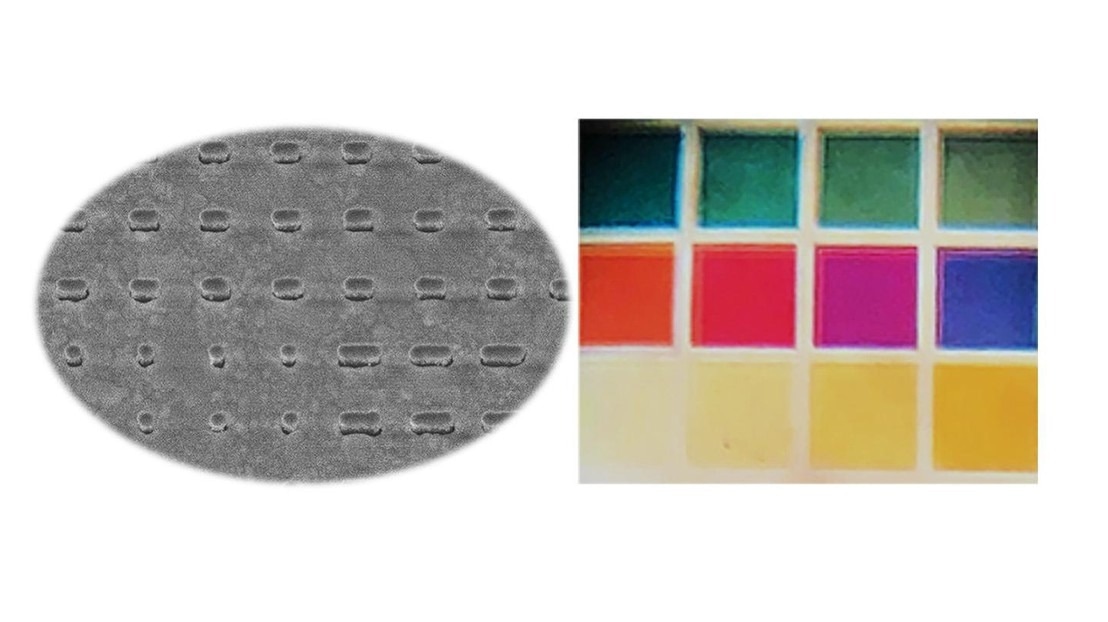Plasmonic nanorods respond differently to light waves that move in the same direction, called polarized light. Depending on how they are positioned and how the light waves are polarized, a chiral response can occur. By changing the length and orientation of the nanorods, many different optical effects can be created that can be used in various applications.

Codable colors (R) reflected by the silver nanostuctures (L) developed in the Nanophotonics and Metrology Lab © NAM EPFL
A recent study published in the journal Advanced Optical Materials discussed the development of a novel encryption system by combining silver nanostructures with polarized light, yielding a wide range of brilliant colors. These colors can then be used to encrypt and transmit hidden messages, providing a secure means of communication.
Structural Colors: Why Are They Important?
Structural colors arise from the interaction of light with micro- and nanostructures. These colors have several attractive features, including high spatial resolution, environmental sustainability, and stability. As a result, they have been investigated for a wide range of applications, such as displays, optical storage, information processing, and encryption.
Various types of structures have been explored for generating structural colors, including grooves, gratings, films, nanoparticles, and apertures. These structures are designed to manipulate how light interacts with them, producing a specific color.
In addition to using different types of structures, researchers have also investigated how the optical response of these structures can be modified by changing the polarization of the light. For example, rectangles, crosses and ellipses have been used to generate different polarization states, allowing for higher information density.
One of the most intriguing applications of structural colors is in the field of optical cryptography. This involves using light to transmit or record hidden information that can only be decoded with the correct key. By using structural colors in this way, it may be possible to develop highly secure and efficient encryption methods for sensitive data.
Challenges Associated with Practical Applications of Structural Colors
While using structural colors for optical encryption has shown promise, several limitations and challenges must be addressed. One challenge is the need for a precise and secure method of generating the correct key to decrypt the information.
Conventional methods utilize a phase key to encrypt and decrypt information. Still, more complex methods have been developed that involve encoding information with orbital angular momentum helical phase and Fourier transform lenses. However, these methods have not yet been fully utilized.
Another challenge is the sensitivity of the spectral response of nanostructures to polarization orientation. While this sensitivity can be used as a key for decryption, it can also make the system vulnerable to attacks that exploit polarization changes.
Additionally, while structural colors can be arranged into grayscale or color images, combining channels in the far and near fields is required to make optical encryption more versatile, such as in binary or color QR codes.
Highlights of the Current Study
In this study, a simple geometry is utilized to demonstrate the potential for optical encryption using a quaternary system. The researchers chose to use silver (Ag) due to its low losses in the visible range of the electromagnetic spectrum.
Each color pixel, or basic cell, has a rectangular Ag nanorod atop a dielectric platform that generates a matching shape aperture inside an Ag mirror underneath. To avoid grating dispersion phases and Wood-Rayleigh abnormalities at the optical wavelengths of interest, the individual cells are organized in a square matrix with a frequency of 300 nm.
As the pedestal height is more than 80 nm, the connection between the nanoparticles and the mirror plane is insignificant.
Before infringing on the sample, incoming light goes via a linear polarizer and a polarization-insensitive beam splitter. The reflected light is then examined using a different polarizer (analyzer).
Findings and Future Perspective
The research has demonstrated that the polarization of light can control the response of plasmonic nanorods. The nanostructures exhibit a chiral response that creates additional field components, resulting in a wide variety of colors that cover 50% of the chromaticity diagram.
This control of the spectral response occurs at a resolution beyond 80,000 dots per inch, allowing for the production of vivid colors ranging from white to black, despite the material not absorbing much light.
The nanorod length and orientation within the unit cell provide additional degrees of freedom for optical control. These effects have been used to reproduce artworks and operate as an encryption system.
The research suggests that this system could be applied in high-density optical data storage, solid-state colors, and encryption.
“Nanomaterials and color are at the crossroads of high-tech and artistry, and I find that very appealing.”, said Olivier Martin, corresponding author of the study. “Using nanostructures, you can encode a huge amount of information onto an extremely small area, so there is the potential for very high information density. At the same time, an approach to encryption that can be read and interpreted by the naked human eye, as opposed to a computer, could be advantageous."
Future research could extend the polarization-controlled spectral response with unconventional meta optics and artificial intelligence.
Reference
Wang, H.-C., & Martin, O. J. (2023). Polarization-Controlled Chromo-Encryption. Advanced Optical Materials. Available at: https://doi.org/10.1002/adom.202202165
Disclaimer: The views expressed here are those of the author expressed in their private capacity and do not necessarily represent the views of AZoM.com Limited T/A AZoNetwork the owner and operator of this website. This disclaimer forms part of the Terms and conditions of use of this website.